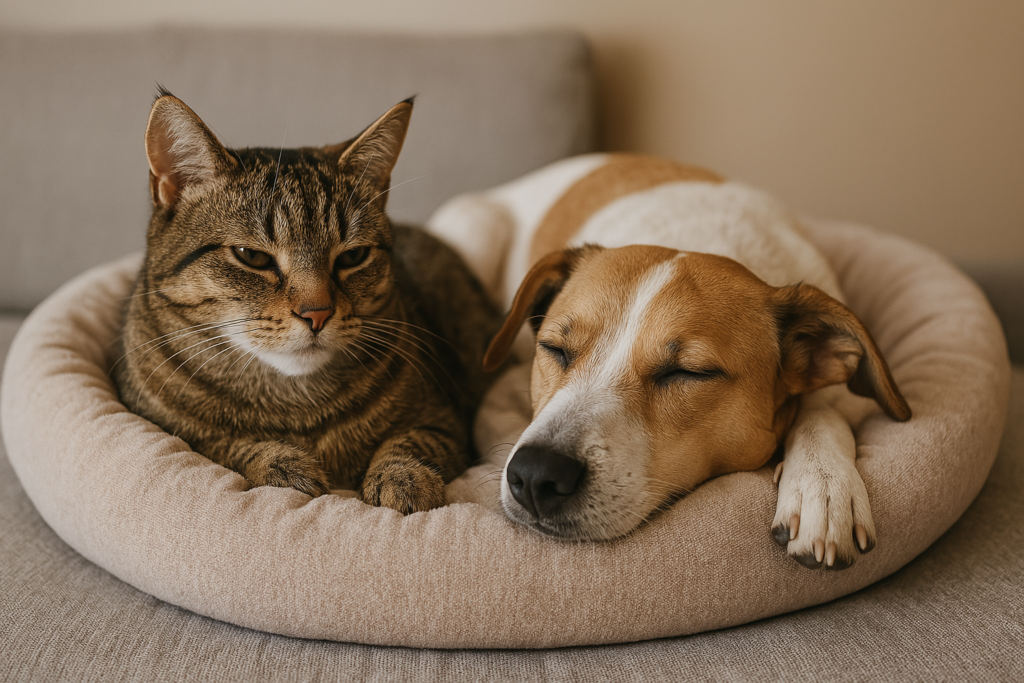Proper hydration is essential for your pet’s health — it helps regulate body temperature, supports organ function, aids digestion, and even affects mood and energy levels. While it might seem like a simple task to provide water, many pets don’t drink enough, and others may have specific hydration needs.
Here’s a complete guide to help ensure your dog or cat stays well-hydrated every day.
Why Hydration Is Crucial for Pets
Both dogs and cats are made up of more than 60% water. When they’re even slightly dehydrated, they can experience:
- Fatigue or lethargy
- Dry nose and gums
- Constipation or digestive issues
- Decreased kidney function
- Poor skin elasticity
- Loss of appetite
In severe cases, dehydration can become life-threatening.
How Much Water Do Pets Need Daily?
Dogs:
A dog needs about 1 ounce of water per pound of body weight each day. For example, a 30-pound dog should drink around 30 ounces (roughly 1 liter).
Cats:
Cats typically need 3.5 to 4.5 ounces of water per 5 pounds of body weight. However, many cats naturally consume less water than dogs, making hydration more of a concern — especially for cats who eat dry food.
Tips to Encourage Your Pet to Drink More Water
1. Keep Water Bowls Clean and Fresh
Dirty bowls or stagnant water are a major turnoff for pets.
- Change water at least once or twice a day
- Wash bowls daily with hot water and mild soap
- Avoid placing bowls near litter boxes or noisy areas
2. Use Multiple Water Stations
Make it easy for your pet to hydrate throughout the day.
- Place water bowls in every room they frequent
- Use non-slip mats underneath bowls to avoid messes
- For multi-level homes, keep a bowl on each floor
3. Try a Pet Water Fountain
Many dogs and especially cats are more likely to drink running water.
- Keeps water filtered and oxygenated
- Appeals to pets’ instincts to drink from flowing sources
- Great for cats that ignore standing water
4. Add Water to Food
Especially helpful for pets on dry kibble.
- Mix water or pet-safe broth into meals
- Serve occasional wet food for cats to increase water intake
- Use a hydration topper designed for pet food
5. Offer Ice Cubes as a Treat
Some pets love the crunch or coolness.
- Drop ice cubes into the water bowl
- Let them lick or chew on ice cubes during hot days
- Use flavored ice cubes (pet-safe broth) for extra appeal
6. Choose the Right Bowl Material
The type of bowl can impact how much your pet drinks.
- Stainless steel or ceramic bowls are easiest to clean and resist bacteria
- Avoid plastic, which can develop scratches that trap bacteria and odors
- Use shallow, wide bowls for flat-faced breeds like pugs or persians
7. Make Water Fun
Turn hydration into enrichment.
- Let your dog drink from a gentle hose stream
- Set up a shallow splash pool on hot days
- Use puzzle feeders with frozen water-based treats
Hydration Tips for Hot Weather
Warm climates or summertime heat increase water loss through panting and evaporation.
- Walk your dog during cooler times of day
- Provide shaded rest spots outdoors
- Always bring a portable water bottle and collapsible bowl for outings
- Increase access to wet food in summer months
Warning Signs of Dehydration
Be aware of these symptoms and act quickly:
- Dry or sticky gums
- Sunken eyes
- Lethargy or weakness
- Panting excessively (for dogs)
- Decreased skin elasticity (gently pinch the skin at the scruff — if it doesn’t spring back, dehydration may be present)
If your pet shows any of these signs and refuses to drink, consult a veterinarian immediately.
Senior Pets and Hydration
Older pets may not feel thirst as strongly, but still need proper hydration.
- Increase water-rich food options
- Monitor daily intake more closely
- Place water bowls near their resting spots
- Offer smaller amounts of water more frequently
Final Thoughts: Keep It Flowing
Hydration is one of the simplest and most overlooked parts of daily pet care — but it can make all the difference in their health and comfort.
By offering clean, accessible, and appealing water sources, and understanding your pet’s specific needs, you’re supporting not only their physical health but also their overall happiness.
A well-hydrated pet is an energized, balanced, and thriving companion.






